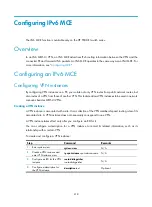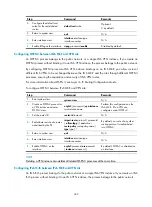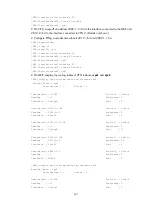
428
Task Command Remarks
Display information about the IPv6
FIB of a VPN instance.
display ipv6 fib
vpn-instance
vpn-instance-name
[
acl6
acl6-number
|
ipv6-prefix
ipv6-prefix-name
] [
|
{
begin
|
exclude
|
include
}
regular-expression
]
Available in any view
Display a VPN instance’s FIB
entries that match the specified
destination IPv6 address.
display
ipv6
fib vpn-instance
vpn-instance-name
ipv6-address
[
prefix-length
] [
|
{
begin
|
exclude
|
include
}
regular-expression
]
Available in any view
Display information about IPv6
BGP peers established between the
PE and CE in a VPN instance.
display bgp vpnv6
vpn-instance
vpn-instance-name
peer
[
ipv6-address
verbose
|
verbose
] [
|
{
begin
|
exclude
|
include
}
regular-expression
]
Available in any view
Display the BGP VPNv6 routing
information of a VPN instance.
display bgp vpnv6 vpn-instance
vpn-instance-name
routing-table
[
network-address prefix-length
[
longer-prefixes
] |
peer
ipv6-address
{
advertised-routes
|
received-routes
} ] [
|
{
begin
|
exclude
|
include
}
regular-expression
]
Available in any view
For commands that display information about a routing table, see
Layer 3—IP Routing Command
Reference
.
IPv6 MCE configuration examples
Using IPv6 ISIS to advertise VPN routes to the PE
Network requirements
As shown in
, the IPv6 MCE device is connected to VPN 1 through VLAN-interface 10 and to
VPN 2 through VLAN-interface 20. RIPng is used in VPN 2.
Configure the IPv6 MCE to separate routes from different VPNs and advertise VPN routes to PE 1 through
OSPFv3.













































